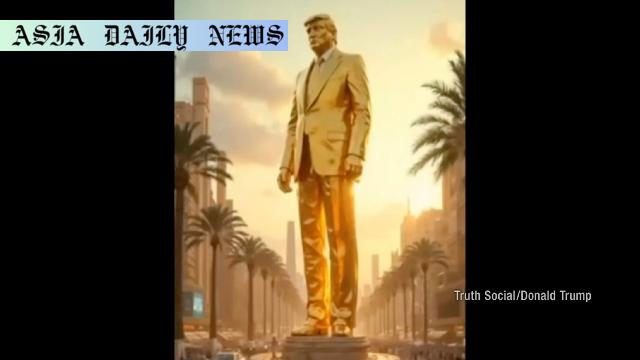Trump Gaza: US President Trump shares AI-generated vision of a reconstructed Gaza featuring luxury resorts, skyscrapers, and controversy.

Introduction: Trump’s Vision for Gaza
US President Donald Trump recently posted a generative AI-created video illustrating his vision of a reconstructed Gaza Strip. The short, 30-second clip transformed an image of current war-torn Gaza into a futuristic coastal resort, complete with towering skyscrapers, luxury accommodations, and a larger-than-life golden statue of Trump himself. The video, posted on his social media, has since generated significant buzz, drawing both admiration and criticism alike due to its content and implications.
The AI-Generated Transformation
The video opens with a bleak depiction of a debris-laden Gaza, a somber nod to the region’s current state. Moments later, the scene dramatically shifts to a reimagined Gaza, now depicted as an opulent city by the sea. Skyscrapers line the coast, a “Trump Gaza” building gleams prominently, and children are shown joyfully playing as money appears to rain from the sky. The imagery is vibrant, promising hope, yet it is also steeped in commercialism, exemplified by the golden Trump statue that stands as a centerpiece. To accompany the visual transformation, a rap-style background song touts Trump as the savior who will “set you free,” adding a cultural edge to the production.
Controversial Political Messages
While the video may appear to some as an innocent exhibition of creative imagination, it carries a significant political undertone. Trump has explicitly stated that the United States plans to “own Gaza for the long term” and is dedicated to rebuilding it. He also suggested that the current residents of Gaza should be moved elsewhere, an assertion that has been met with condemnation. Nations in the Middle East and Europe have issued strong statements, highlighting that such comments not only ignore Palestinian rights but also violate international laws regarding territorial sovereignty and human dignity.
Reactions Across the Globe
The reaction to the video and Trump’s accompanying statements has been polarizing. Supporters of Trump have lauded his “visionary leadership,” with suggestions that his ideas could bring unprecedented development to a historically conflict-ridden region. However, critics argue that the vision is out of touch with the harsh realities of the Gaza crisis, where basic needs like food, clean water, and housing are immediate priorities. Middle Eastern governments have particularly voiced outrage, viewing the video as an oppressive stance that undermines the complexity of the Palestinian-Israeli conflict.
The Role of AI in Political Messaging
This incident raises questions about the role of generative AI when paired with political messaging. While AI can produce compelling visuals and narratives, its use in such contexts can blur the line between imaginative representations and actionable plans. In “Trump Gaza,” the generated clip piqued curiosity but also stoked division. As AI tools become more accessible, the ethical use of this technology in shaping public opinion must be closely examined.
The Bigger Picture: Implications and Ethics
The debate over the Gaza video underscores a larger issue—how leaders communicate their ideas, and whether those ideas respect the rights and aspirations of affected populations. Trump’s Gaza video, while striking in presentation, showcases a top-down, outsider-driven vision that discounts the voices of those it purports to aid. In the context of ongoing tensions and humanitarian concerns in the region, the video has reinforced global discussions on the need for more inclusive and lawful approaches to addressing crises.
Conclusion
Trump’s AI-generated vision for Gaza has undeniably succeeded in grabbing attention, but its polarizing impact on the international stage is a reminder of the high stakes inherent in political messaging. As global leaders take cues from technological innovations to communicate and inspire, they must tread carefully to ensure that their visions uplift and unite, rather than alienate and divide. The ongoing dialogue about the Gaza video sheds light on broader issues of accountability, ethics, and the responsibility leaders bear when shaping the future of vulnerable regions.
Commentary
A Provocative Vision: Exploring “Trump Gaza”
There is no doubt that President Trump’s AI-generated vision for Gaza has sparked a debate that traverses politics, ethics, and technology. The very idea of transforming a war-torn region into a futuristic utopia is audacious, but it also raises questions about feasibility, sensitivities, and the rights of those who inhabit such conflict zones. One cannot help but wonder whether this vision reflects genuine intent or is merely a marketing tool aimed at garnering attention and sparking conversation.
Mixed Reactions: A Divided Global Audience
The polarizing reactions to the video highlight the deep complexities of the Gaza crisis. Supporters may see Trump’s vision as a bold and innovative initiative to bring prosperity to a region long plagued by conflict. Yet, critics rightly point out that such proposals risk oversimplifying the issue, disregarding the lived experiences and rights of Palestinians. For many, the golden Trump statue and rain of cash epitomize shallow symbolism, disconnected from the realities on the ground.
The Ethical Implications of AI-Driven Messaging
Another facet of this discussion is the use of generative AI in shaping political narratives. While the technology undeniably offers novel ways to engage audiences, it also poses ethical questions, particularly when used to broadcast controversial or potentially harmful messages. Should AI be wielded to create such divisive content, and what responsibilities do public figures have in regulating its use? These are important considerations as the world grapples with the expanding role of AI in public discourse.
Final Thoughts
Ultimately, the “Trump Gaza” vision is both a thought-provoking and contentious depiction of what leadership and reconstruction could look like in challenging regions. While it draws attention to Gaza, it also risks trivializing the struggles of those who live there. It is a reminder of the power—and danger—of speculative visions, particularly when they fail to involve those who stand to be most affected. This balance between inspiration, feasibility, and inclusion will be key as such ideas continue to garner attention on the global stage.


